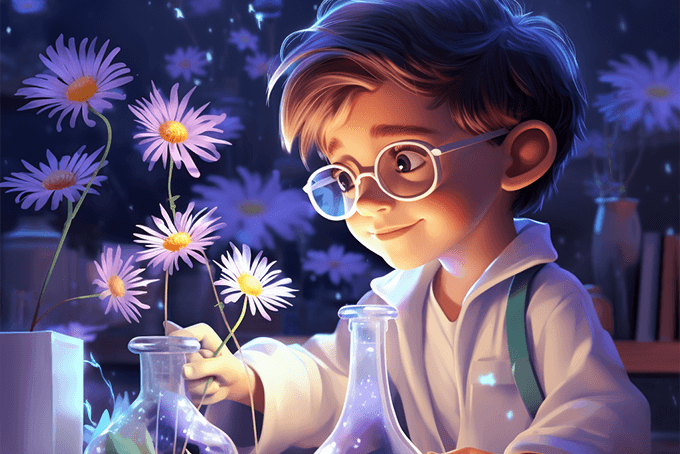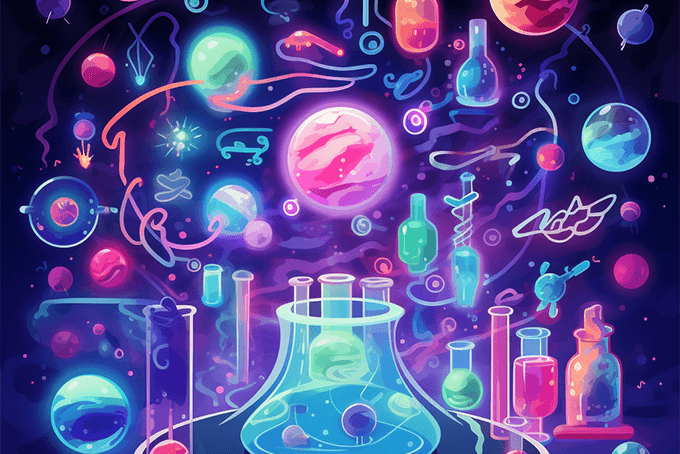Science experiments are a wonderful way to educate and entertain kids – and you might find yourself learning a thing or two, too! Conducting interesting investigations are as simple as using items from the kitchen cabinet. Children of all ages will enjoy finding out what happens next, engaging their brains to figure out intelligent conclusions all while conducting experiments.
Fun Science Experiment for Kids Ages 3 to 5
Even the very young can enjoy an interesting science experiment. Learning is an amazing thing at this age, and just about everything gets kids excited about science and using their brains. See what happens when white daisies and food coloring come together with this simple science activity.
- Purchase some white daisies with your child and discuss how flowers grow with the help of sun, water, and soil.
- Ask the child what she think would happen if a cut flower wasn’t placed in water. Help write her ideas on a sheet of paper in a notebook, creating a science journal for the experiment. Also, ask her what might happen if food coloring was added to the water the flowers are placed in.
- Place one cut daisy in a glass with no water and one in a glass with just water. She can help fill a couple other glasses with water and then add two to three couple drops of food coloring creating additional glasses with colored water for daisies to be placed in.
- Help the child create a chart on her paper to document the science experiment and the changes in the flowers every couple hours.
- After 24 hours, discuss what has happened to each flower helping her mark the changes in her science experiment journal. She can also take photographs of the flowers to put in her journal alongside the finished chart, to visually show the results.
- Discuss her original ideas and what really happened. Cut flowers pull liquid through their stems and up through the flower’s petals. Without water, the flower will eventually dry out. The water with food coloring changes the colors of the petals, showing how water moves through the flower.
Fun Science Experiment for Kids Ages 6 to 9
- Everyone likes a refreshing soda – but how is it made? Create a fun and tasty science experiment with kids by making a homemade lemon-carbonated beverage, learning more about how acids respond to a base!
- Discuss with the child how they think a carbonated beverage might be made and create a list of all her creative ideas. She can even draw a picture of how she thinks the process might take place, motivating her left and right brain to work together in solving the problem.
- Gather the ingredients needed including a couple lemons, water, baking soda, sugar, and measuring spoons and cups.
- Ask the child what she thinks might happen if all the ingredients were mixed together – would it turn into a tasty treat? Help her write out a scientific hypothesis, or idea for combining the ingredients.
- Start by squeezing one of the lemons to create enough liquid to fill 1 Tablespoon. If necessary, use another lemon. She can measure out the juice and add it to a tall glass.
- Now she can measure 1-cup of water and add it to the juice. Ask her to taste the liquid and document any changes on her paper.
- See what happens when the child measures 1-teaspoon baking soda and adds it to the mixture. Encourage her to write her observations and taste the result. She can add sugar to the liquid to adjust the flavor as she wishes.
- Discuss the experiment and the reason why the baking soda changed the liquid. Baking soda is a base and lemon juice is an acid. In this case, when the baking soda and lemon juice interact, a reaction takes place, creating carbon dioxide. Carbon dioxide is what causes all the bubbles in soda! She just created her own fizzy beverage!
- The child can experiment making other carbonated beverages with ingredients such as orange, pineapple, or limes. She can write down the recipes so the beverages can be created again and again.
Science Experiment for Kids Ages 10+
Learning about basic chemistry can be turned into an art activity dealing with surface tension. Water is a molecule that can be manipulated in many unique ways, often causing it to be taken for granted. Use water, cooking oil, and tempera paint to create an interesting science activity, with colorful results.
- Have the child fill a 9 by 12-inch baking pan with 1-cup of water.
- Discuss with the child how different ingredients might affect the surface tension of the water. Oil and water are considered immiscible. She can define the word to use in her documentation of the science experiment. Have her use the scientific method to help write out her ideas, including a hypothesis, procedure, and conclusion on a sheet of paper.
- Now she can add 1 Tablespoon of cooking oil to the tray and use a whisk to mix the water and oil, documenting the results.
- After she has observed the changes, she can add a couple drops of tempera paint to the tray and once again whisk. Observe what happens and note the results.
- Now she can place a sheet of white drawing paper on top the tray, gently floating the paper on the water for a second and then laying it out flat on a couple sheets of newspaper.
- Because oil and water do not mix, the paper picks up trace amounts of oil floating on the surface along with some of the colored water, creating marbled paper.
- She can experiment by mixing oil with the tempera paint and then adding it to the water or using colored construction paper instead of white paper for different artistic results. She can document the different experiments along with their results.
Fun science experiments offer exciting ways to engage kids in learning, and encourage their brains to think in new ways.



